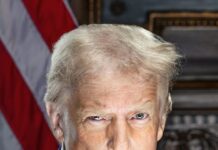On January 6th, Trump supporters and far-right groups, spurred on by the lies and rhetoric of Trump and his allies, attempted to take the Capitol with the goal of violently stopping Congress from certifying Biden’s election.
President Trump orchestrated a rally in Washington DC to protest the election results. After the rally, his supporters and far-right groups descended onto the Capitol Building. Many managed to break in, vandalizing it and seeking to harm those inside. The horrendous attack drew sharp criticisms from domestic and international leaders. Many blamed Trump and his allies for inciting the insurrection due to their violent rhetoric and baseless allegations that Biden had stolen the election. Multiple social media websites banned the President’s accounts, fearing that his messaging would incite more violence. Democrats pushed to get the President out of office, leading to his 2nd impeachment in the House.
So how exactly did everything go down? Here’s a timeline of events with all the information we know.
The Attack on the Capitol Building
Groups Involved
American, Confederate, and MAGA flags flew at the riot. This marked the first time in American history that a Confederate flag was flown in the Capitol building. One man’s shirt read “Camp Auschwitz, work brings freedom,” which was the slogan of the concentration camp. Another’s read “6MWE,” a neo-Nazi reference to the Holocaust meaning “6 Million Wasn’t Enough.”

The Proud Boys, a violent, white-nationalist group, was also involved. In a presidential debate, then candidate Biden asked President Trump to condemn them. Instead, he told them to “stand back and stand by.”
Many QAnon believers were also present, carrying various clothes and apparel marked with their symbols. They believe the bizarre conspiracy theory that “Q” is someone who is helping expose a global, cannibalistic, Satan-worshipping cult that is trying to undermine Trump’s presidency. Their beliefs likely influenced their violence in DC. One man, known as the QAnon Shaman, was charged with violent entry into the Capitol.

The FBI’s investigation found former and current military personnel, police officers, and even Republican lawmakers participated in the siege. Many of them were suspended or resigned, and the FBI is continuing its investigations to see who else was involved.
Lastly, in the hours after the insurrection, many claimed that Antifa and BLM was involved. This is untrue, apart from one man with hazy ties to these movements. Many argued that if BLM or a Muslim group had been present, the police response and public outcry against them would have been far worse.
Breaking into the Capitol
Spurred on by Trump’s words before and during his rally, many of the former President’s supporters marched towards the Capitol. Others had already been congregating near or around the Capitol.
The rioters made their way into the Capitol through different means. Videos surfaced of mobs of Trump supporters beating, dragging, and stomping on Capitol police. The protestors injured tens of DC police using fists, poles, clubs, pipes, chemical irritants, and electroshock weapons. One officer died as a result of being struck in the head with a fire extinguisher. Several days after the riot, an officer who served at the Capitol committed suicide.
Others made their way into the Capitol with the help of policemen. Videos show police opening up the gates to the Capitol to the rioters. More egregiously, some took selfies with the insurrectionists inside the building. Multiple videos also show protestors physically breaking into the building through doors and windows.
Lastly, while no explosives were used, the FBI found 2 pipe bombs on the day of the riot. One was placed at the RNC HQ and the other at the DNC HQ. However, they were found and safely detonated before any harm could be done. Additionally, police arrested a protestor for carrying 11 Molotov cocktails.
Attack on Congress
January 6th marked the day that Congress would certify the electoral college victory of Joe Biden. While some protestors were angry about Biden’s victory through alleged fraud, some wanted to overturn the election altogether. Their plan was to capture and kidnap certain lawmakers in an attempt to prevent the certification from taking place. Reporters and others overheard threats of violence or murder from the rioters. The FBI led an exhaustive investigation into online threats, especially towards specific lawmakers. Several were seen carrying zip-ties and plastic cuffs, presumably to take hostages.
The Senate
As the Capitol was sieged, protestors built a gallows with a noose just outside the building. The mob chanted to “Hang Mike Pence,” influenced by Trump’s criticism of his own Vice President. Trump had previously asked Pence to unconstitutionally overturn the election’s certification. Pence announced he would not do so, leading to further criticism from Trump and his allies.

As the protestors made their way through the building, Congress had split into the House and Senate chambers to debate independently. Secret Service members evacuated Vice President Pence from the Senate and Speaker of the House Nancy Pelosi from the House.
Not all lawmakers made it out on time however. A viral video later showed Capitol officer Eugene Goodman leading rioters away from the unlocked Senate doors, with senators still inside. Goodman, a black officer, did his best to lead away white supremacist rioters away from the Senate. Many commended his actions, and he later escorted Vice President Kamala Harris at the inauguration.
However, rioters were able to briefly take control of the Senate chamber. One rioter went viral after making it into Pence’s chair in the Senate. Another video showed rioters looking through Senators’ notes, trying to find evidence of sedition. Some are heard saying that Senator Ted Cruz of Texas, who was objecting to the results, would have approved of their storming of the Capitol. Lastly, another video showing police politely asking white rioters to leave the Senate floor drew intense public criticism.
The House
The scene in the House became immensely chaotic. Like in the Senate, not all of lawmakers were able to leave in time. Officers handed out and ordered those present to wear gas masks since officers had used tear gas against the protestors. At one point, gunshots were fired near the front door of the House chamber. A standoff took place between the mob trying to break in and between the armed officers.

Rioters targeted House Speaker Pelosi, a Democrat, during the siege. The rioters broke into her office, vandalizing it and looting her belongings. Two of them became national headlines. One was photographed sitting in Pelosi’s chair, and another was seen stealing her lectern. Law enforcement arrested both of them and many others. Speaking to her followers, Congresswoman Alexandria Ocasio-Cortez would later admit that she and some of her colleagues believed they were going to die during the riot.

Individual Protestors
The FBI and other law enforcement agencies arrested and questioned many of the previously mentioned protestors. Many incriminated themselves by posing for pictures or for documenting their actions on social media.
Four rioters died as a result of the Capitol siege, and of those four, two who died likely did not participate. One of the protestors was trampled to death as people broke into the Capitol. Most prominently among those who died was Ashli Babbitt, a former veteran and QAnon theorist. Video shows protestors breaking the window of locked doors leading to the House. A Capitol officer fatally shot her as she tried climbing through the just broken windows. Although she was unarmed, many officers were aware that the insurrectionists were carrying concealed weapons.
Leadup to the Attack
Allegations of Election Fraud
Months before the election, President Trump claimed that the Democrats would rig the election against him. In the presidential debates, Trump repeated baseless claims of election fraud in several battleground states.
In the aftermath of Biden’s victory, Trump’s legal team began a massive battle in the courts. However, they lost over 60 cases across the 6 key states: Arizona, Georgia, Nevada, Michigan, Pennsylvania, and Wisconsin. Many of their claims included election law violations, ballot harvesting and selling, dead or duplicate voters, rigged voting machines, etc. However, Democrat and Republican appointed judges, included some appointed by Trump, threw out or rejected their cases. Trump’s evidence was thin and false, leading to his court losses.
Anger among Trump supporters increased following the Georgia Senate runoffs on January 5th. Democrats managed to take both seats, giving them a majority in the Senate. Allegations of fraud from Trump and his supporters ramped up further after these elections. In November and January, Democrats overwhelmingly voted using in-mail voting. The natural explanation is that they were more concerned about COVID-19 than Republicans, partly due to Trump’s downplaying of the virus.
Lastly, Republican House members and Senators objected to Biden’s electoral certification on January 6th. Many had announced their plans to do so before, citing debunked allegations of fraud. For months after Biden’s victory, Trump and his allies used these same baseless claims to rile up their supporters. At rallies and on TV, they repeated these claims and used violent rhetoric. Their lies incited deep and genuine anger, leading to the attempted coup at the Capitol to overturn the election.
Save America March and Rally
In December, President Trump announced his plans to hold a rally and a march in DC to protest Congress’ certification of Biden’s electoral victory. This gave plenty of time for far-right groups to plan their siege of the Capitol. The FBI and others found obvious clues of planned violence at the Capitol and against lawmakers online. Despite this, preparations to protect the Capitol and other state legislatures across the country were incredibly lax.
After Trump’s announcement, many of his prominent allies used violent rhetoric to paint January 6th as a last ditch attempt to “Save America.” Many called for strength, criticizing Republicans who opposed Trump’s baseless claims by calling them weak. Some threatened to “come after” the supposedly traitorous Republicans. Others spoke of the American Revolution, citing the need to fight like the colonists. Others went so far as to explicitly call for the occupation of the chambers of Congress.
The Republican rhetoric reached a peak at the rally and march on January 6. Trump, his family, and his allies spoke at the rally. They repeated their baseless claims of election fraud and threatened Republicans who had disagreed with Trump. They also used violent rhetoric to rile up the crowd, calling on them to march on the Capitol. The most direct call for violence was Rudy Giuliani’s speech, calling for “trial by combat.” Trump’s speech echoed all of these sentiments, asking for his supporters to “fight like hell.”
Aftermath of the Attack
Damage to the Capitol
The rioters left the Capitol in ruins. Shattered glass from broken windows and debris from broken doors and furniture was strewn across the Capitol grounds. The rioters used graffiti to write violent messages. Vandalism and the use of chemical irritants damaged various statues, paintings, and other items of historical importance in the Capitol. The rioters also stole several items, including high-security level laptops from lawmakers.
Trump’s Reaction to the Capitol Attack
Having told his supporters to march on the Capitol, Trump was initially pleased to see their progress. As violence erupted between his followers and the police, he tweeted twice, asking them to stay peaceful and to respect the officers. Trump deployed the National Guard fairly late, about an hour and a half after the rioters had broken in.
The President finally called for the mob to disperse 2 hours after they had broken in. However, he used his video to repeat the claims of election fraud. He also told the rioters that, “We love you. You’re very special.” Some of these people were actively seeking to kill certain members of Congress. Others destroyed and vandalized important items inside the building. The groups involved included white supremacists and neo-Nazis, yet Trump did not condemn the people involved or their actions.
Trump and his allies were very harsh against BLM-related riots in August but barely condemned the attack on the Capitol. Trump once tweeted that “when the looting starts, the shooting starts.” He instead told the looters at the Capitol that he loved them. Days later, Trump read a forced speech to condemn the attack.
Congress’ Response and Forcing Trump Out of Office
Republicans were planning to continue objecting to some of the states’ results. After the violence that occurred, many went back on their plans. Congress was able to certify Biden’s victory more quickly that night once they came back together.
Democrats in the House and the Senate sought to remove Trump from office before he could incite more violence. Their first method was to ask Vice President Pence to invoke the 25th Amendment to assume the duties of the Presidency. This would allow Pence and a majority of Cabinet secretaries to declare Trump unfit to serve for office. Pence declined Democrats’ calls to invoke it, and several Cabinet secretaries, including Betsy DeVos, resigned instead.
Instead, Democrats opted for impeachment. On the charge of inciting insurrection, Trump was impeached in the House. All Democrats and 10 Republicans voted in favor, marking the first time a President has been impeached twice. The next step will be the trial in the Senate. Despite the end of Trump’s presidency, he could still be impeached based on historical precedence. The trial will begin on February 9th. If 2/3 of the Senate convicts him, a simple majority of the Senate can disqualify Trump from holding office ever again.
Bans on Social Media
On various social media sites, Trump received multiple warnings of spreading disinformation. Following the failed coup, all major social media sites, including Twitter, YouTube, Facebook, Snapchat, and Instagram, banned or shut down Trump’s accounts. This was for his continued lies and out of fear that he would incite more violence.
The accounts of Trump’s allies also received similar treatment. Trump and his supporters increased their calls against Big Tech’s perceived censorship of free speech. However, since they are private companies, they are not violating the 1st Amendment by banning their accounts. This does raise the genuine question of how much these companies should or should not use their immense power to regulate speech online.
Final Thoughts
President Trump is leaving office with one of the lowest approval ratings in modern history. Using lies of election fraud and violent rhetoric, the President and his allies incited an insurrection to try and overturn a fair election. Many of his allies supported overturning the same supposedly illegitimate elections that granted them power. Had there not been checks in place against Trump, had people like his own Vice President not stood up against him, the democratic institutions of our country could have been demolished. The actions of Trump and his allies were nothing less than authoritarian.
Those involved in the failed coup included far-right and racist groups who the President has repeatedly failed to condemn throughout his presidency. Despite their calls of supporting the police, they violently broke into the Capitol, injuring officers. One officer was killed, and four rioters died. They actively hunted lawmakers and vandalized the most sacred place of democracy in our country. The President told groups of white supremacists, neo-Confederates, and neo-Nazis that he loved them and that they were special.
I am appalled by the actions of the President, his powerful allies, and his supporters in this insurrection. The FBI must continue investigations to prosecute, arrest, and bring justice against all those who incited the violence and who participated in it. For their role in the riot, Trump and his allies in positions of power must resign, be impeached, and never be allowed to hold office again.






